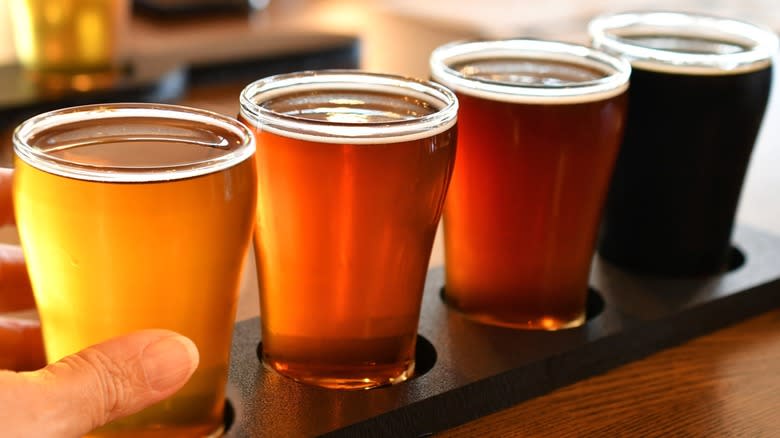The Key Tip To Ensure The Most Enjoyable Beer Tasting Experience

One of the best parts about the American craft beer boom of the 21st century has been seeing beer tastings start to get taken seriously in a way historically reserved only for wine tastings. Once dismissively relegated to a massive, all-inclusive category called "beer," now even average consumers understand that there can be a world of difference between a pilsner, an ale, and a bock.
And just like a California merlot can be a very different experience from a French one, variations in ingredients and brewing techniques mean that two beers of the same style can have very different flavor notes depending on the producer. Beers can be hoppy, malty, fruity, bitter, nutty, chocolatey, and so much more. This newfound widespread acknowledgement means that beer tasting has taken off as an activity, both in breweries themselves and in the form of flights. But if you want to give beer the same respect people give wine, there are some beer tasting best practices to follow -- and a big one is tasting your samples in the right order.
If you order a beer flight, you'll probably notice that they come arranged from lightest to darkest most of the time. Well, that doesn't just look nice, it's the actual order you should follow in tasting them. While both light and dark beers can cover a wide variety of flavors, dark beers do tend to be more intense. And if you taste them first, you risk overwhelming the lighter beers you sample afterwards.
Read more: 15 Popular Hard Seltzer Brands, Ranked Worst To Best
Taste Lighter And Lower ABV Beers First

Although not all dark beers will hit as hard as an imperial stout, for example, the color of your beer is a good indicator of how strong the flavor is, because a beer's hue is tied to how roasted the malt or grain is. Like any heat application with food, longer roasting of the malt brings out deeper, more complex flavors through the Maillard reaction, giving dark beers strong, full notes that are usually toasty, malty, and sweet.
And similar to what occurs with food and alcohol pairings, our taste perceptions change based on what we are drinking together, so a crisper, cleaner light beer may taste watery and bland if you sip it after a dark beer, even if it would be flavorful on its own. That doesn't mean lighter beers aren't as satisfying, just that their more delicate flavors need to be treated that way. The two other factors to consider when determining sampling order also relate to how strong a beer tastes: alcohol by volume (ABV) and hoppiness.
If you are mostly tasting beer that's in the same color range, these two measures are the best way to determine which beers will overwhelm the others. ABV is usually listed on the menus these days, but outside of more obviously hop-heavy varieties such as IPAs (which come in many styles), you may need to ask about hoppiness before you taste. Every type of beer deserves to be given a chance to shine, so make sure you don't ignore their potency when it's time to sample them.
Read the original article on Tasting Table
